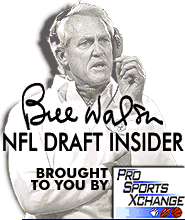
How I Evaluate Each Position:
Wide Receiver
By Bill Walsh
PSX Draft Insider Special
|
|
How I Evaluate Each Position: Wide Receiver By Bill Walsh PSX Draft Insider Special |
WIDE RECEIVER
Ideal size: 6-3, 210
The critical factor at wide receiver in my mind is agility and body control, the ability to change your body position often off the g round in order to get your hands in position to make the catch, ala Cris Carter of Minnesota. He would be the ideal in that respect.
That particular characteristic must be there for the receiver to be considered a Pro Bowl or a Hall of Fame player. You must have that to get to the highest tier of play.
Secondly is strength. That is somewhat related to girth. You need to power through players. When you are bounced into players you must be able to keep your feet, regain your balance and move into position and continue your pass route. So there has to be a certain amount of strength, as Jerry Rice or John Taylor demonstrated so often with the 49ers.
Hands are vital, but you almost have to assume that anyone you are considering is going to have outstanding hands. The difference between players is the agility and strength that was mentioned. That allows them to get into position to make the catch, to use their hands.
We can have drills where the receiver is running under the ball and making great catch after great catch. So people would assume that he has outstanding hands. But in reality, most catches are made with the ball and the defender closing at the same instant and the receiver having to reverse his body into a totally different position, get your hands up and catch the ball and be hit at the same moment. That is the key element in greatness -- agility and strength together.
Focus is critical here. The ability to find the ball, focusing on it and isolating it from everything else that's happening. When you are evaluating the tapes, you look for those plays that demonstrate those situations. You make a evaluation tape of those plays.
You establish the criteria that you require. Then you have a tape that demonstrates those requirements.
Pure speed is helpful, but full-stride speed becomes important. You would like a receiver with the ball in the open field to be able to keep the separation with the closing defenders until he gets over the goal line. He doesn't have to outrun them. He doesn't have to gain ground on them. He just has to get there before they do so he scores. So it doesn't have to be sprinters' speed, but full-stride speed.
A good example of that was Mike Quick when he was at Philadelphia. He had just an average 40 time, but once in the open field the long strides gave him the functional speed to stay away or get away from defenders. Dwight Clark, believe it or not, was never caught from behind once he got into full stride. Now he used the field to weave and bend, but he was never caught. And Jerry Rice will never be caught from behind by anyone if they both have the same, basic starting point.
Now there have been other people who have been Olympic sprinters who get tangled up and can't get back into full stride quickly enough and somebody just comes up and overwhelms them from out of nowhere. If they catch the ball and there is any contact at all, by the time they get back in running stride, the people have closed on them. Full-stride speed is the key.
Coaching becomes a factor in regards to their ability to evade at the line of scrimmage and their ability to read the form of coverage and their ability to change a pattern accordingly. That all comes through coaching, training and their focus in a game.
Durability is a factor because they are going to be hit a lot. And they are going to be hit when they are in a vulnerable position at times. And they are going to be hit by much bigger men when they catch a hook pattern against a linebacker.
Injuries are key because at this position injuries impair their ability to function at a high level, especially when compared to, say, an offensive lineman who can play damaged. Wide receivers are finely tuned athletes who need to be in top condition to perform well. If they are in any way damaged, it is difficult for them to function at a high level.